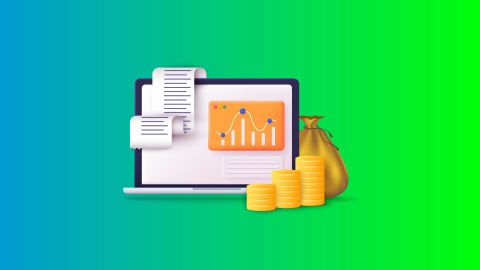When it comes to investing, most people are looking for a simple yet effective way to grow their money. That’s where mutual funds often come into play. But simply investing in one mutual fund may not be enough. If you truly want to balance risk and reward, you need something more structured a mutual fund portfolio.
A mutual fund portfolio is essentially a mix of different mutual fund schemes designed to meet your personal financial goals. Whether your priority is long-term growth, income generation, or risk reduction, building a portfolio tailored to your needs helps you stay on track. In this article, we’ll walk you through what a mutual fund portfolio is, how to build one, and how to monitor its performance so that your investments continue working hard for you. If you're unsure how to begin, understanding the role of each fund type in a portfolio can help you take that first confident step toward long-term investing. Start Investing or SIP with Just Rs. 100!
What is a mutual fund portfolio?
A mutual fund portfolio is a combination of different mutual fund investments chosen based on your personal financial goals, risk appetite, and investment timeline. These portfolios can include various types of funds like equity, debt, hybrid, index-based, and sector-specific funds.
The main goal of such a portfolio is to distribute your investments across asset classes to reduce risk while aiming for better returns. For example, a young investor looking for growth might lean heavily into equity funds, while someone nearing retirement may prefer a mix with more debt-oriented funds for stability.
Curating a mutual fund portfolio involves selecting funds that are in sync with your objectives and your comfort with market ups and downs. By doing this, you avoid relying on a single fund or asset class, which could be risky in volatile markets. A balanced mutual fund portfolio can serve different life goals—from short-term needs to long-term wealth creation—without relying solely on one fund type or sector. Compare Mutual Fund Options Now!
Composition of a mutual fund portfolio
A well-structured mutual fund portfolio is not thrown together randomly. It has several components, each playing a specific role in shaping your investment journey.
Asset allocation forms the foundation. This means spreading your money across equity, debt, and other asset types based on your risk tolerance and investment horizon. Next comes diversification—investing in different types of mutual funds ensures that if one underperforms, the others may balance out the impact.
Risk management is another essential layer. Based on your comfort with risk, you can choose funds that suit your style whether you prefer stability or are open to taking some chances for higher returns.
Lastly, the portfolio should be growth oriented. Choosing funds that are aligned with long-term wealth creation goals can help your money grow steadily over time.
Purpose of a mutual fund portfolio
There are several key reasons why having a mutual fund portfolio makes sense for investors across all experience levels.
First, it helps with wealth creation. By investing in the right mix of funds, you can steadily grow your money over time. It also acts as a tool for risk management. Since your funds are spread across different asset classes, the impact of market volatility is often reduced.
If generating regular income is your goal, your portfolio can include income-focused funds that offer dividends or interest payouts. Similarly, you can align your portfolio with specific life goals whether it's saving for a child’s education, buying a home, or planning for retirement.
Another benefit is liquidity. Mutual funds are relatively easy to buy and redeem, offering flexibility in case you need access to your funds. Lastly, you benefit from professional management. Fund managers actively track and adjust fund holdings, saving you the time and effort it would take to do it yourself. Creating a mutual fund portfolio isn't just about investing—it's about simplifying wealth building with flexibility, expert management, and the option to start small. Save Taxes with ELSS Mutual Funds!
Why should you create a mutual fund portfolio?
If you’ve ever felt confused about how to start investing, or worried about taking on too much risk, building a mutual fund portfolio can be a smart and manageable way to begin. It gives you the benefit of diversification, which means you're not putting all your money in one place. This can reduce the overall risk of your investments while still giving you a chance to earn good returns.
What makes mutual fund portfolios even more attractive is that they are managed by experienced professionals fund managers who analyse the market and take decisions on your behalf. You don’t need to be an expert to get started.
Another advantage is accessibility. You don’t need lakhs of rupees to build a meaningful portfolio. With some platforms, you can start investing with just Rs. 100 per month. This makes it easier for beginners or small investors to participate and benefit from long-term market growth.
And if you’re short on time or lack investment knowledge, mutual fund portfolios simplify things. The fund manager does the heavy lifting—like researching, selecting assets, and tracking performance—so you don’t have to.
Lastly, mutual fund units are quite easy to redeem. You can access your money quickly if needed, and thanks to daily NAV updates, your investments remain transparent. You always know what your mutual fund is worth.
How to build a mutual fund portfolio?
Here’s a step-by-step run-down on how to build a mutual fund portfolio:
Set your goals and risk tolerance
Outline your financial goals be it buying a home, higher education, or retirement planning. Next, evaluate your risk appetite. This involves understanding how much risk you are willing to take on.
Research and choose funds
With your goals and risk profile in mind, consider various types of mutual funds including equity, hybrid, debt, and balanced funds. Carefully evaluate factors like the fund’s past performance, expense ratio, and the fund manager’s credentials.
Diversify your investments
Avoid putting all your eggs into one basket. Diversify your mutual fund portfolio with different types of funds and sectors to hedge volatility associated with a single fund type/sector. For instance, you can curate a mix of domestic equity funds and international mutual funds or a mix of sector-specific funds and broad-market index funds. Diversification is key to minimising risk and maximising returns. To make informed decisions, it is essential to compare different mutual fund options based on their risk, returns, and objectives. Compare Mutual Fund Options Now!
Allocate your assets
Based on your investment objective, risk profile, and time horizon, decide on how much you wish to allocate to different asset classes in your portfolio. Young investors can opt for a higher equity exposure for potentially better returns over time, while those nearing retirement can benefit from the stability of debt asset investments.
Regularly review and rebalance
Periodically reviewing and rebalancing your mutual fund portfolio keeps in tune with changing market trends and your evolving financial goals. Rebalancing helps maintain the original asset allocation plan which may have shifted due to varied sectoral performances.
How to choose the right mutual funds portfolio for income
- Define your income requirement:
Start by identifying how much regular income you need and how often. Monthly or quarterly income needs will influence the choice of funds and withdrawal strategy. - Assess your risk tolerance:
Income portfolios should balance stability and return. Conservative investors may prefer debt-oriented funds, while moderate investors can include some equity exposure for better inflation protection. - Focus on debt and hybrid funds:
Consider debt funds such as short-duration, corporate bond or banking and PSU funds for predictable income. Conservative and balanced hybrid funds can add stability with limited equity exposure. - Use SWP instead of dividends:
A Systematic Withdrawal Plan (SWP) offers tax-efficient and predictable cash flows compared to dividend options, which depend on fund performance and are taxed as income. - Diversify across fund categories:
Avoid relying on a single fund. Spread investments across different debt maturities and fund houses to reduce credit and interest rate risk. - Check credit quality and duration:
Prefer funds with high-quality portfolios and moderate duration to reduce the risk of defaults and sharp NAV fluctuations. - Account for taxation:
Understand how capital gains are taxed based on holding period. Post-tax income is more important than headline returns. - Review expense ratios:
Lower expense ratios help preserve income over time, especially for long-term income portfolios - Rebalance periodically:
Regular reviews ensure the portfolio continues to meet income needs and adjusts to changing interest rates and personal goals.
Factors to consider before building a mutual fund portfolio
Before you dive into selecting mutual funds, it’s important to step back and evaluate a few personal factors that can impact your investment journey. Think of this as building the foundation for your portfolio.
The first factor is your financial goals. Are you investing for a short-term goal like a vacation or a long-term one like retirement? Your goals will determine how aggressive or conservative your investments should be. For example, long-term goals allow room for equity-based funds that may fluctuate in the short run but offer strong returns over time.
Next, assess your risk tolerance. This is your comfort level with market ups and downs. If you're young, earning well, and okay with taking risks, you might be more inclined towards equity funds. If you’re risk-averse or close to retirement, debt or hybrid funds may be more suitable.
Diversification is another key factor. A good mutual fund portfolio shouldn’t be overexposed to one asset class or sector. Spreading your investments helps reduce the impact of volatility.
Also, don’t ignore expense ratios and fund fees. These are charges fund houses apply for managing your money. A higher expense ratio can eat into your returns over time, especially for large or long-term investments. Review all associated costs like entry/exit loads and ongoing charges before committing to a fund.
Building a diversified mutual fund portfolio
Diversification is one of the smartest strategies you can use in investing. Rather than relying on a single type of fund, spreading your investments across different sectors, asset classes, and even geographies can help you balance risk and returns.
For instance, putting money in both equity and debt funds can help you tap into growth opportunities while still maintaining stability. Equity funds can be volatile but offer high return potential, while debt funds provide more consistent, lower-risk returns.
You can also diversify within equity funds—choose a mix of large-cap, mid-cap, and small-cap funds. Large-cap companies offer stability, mid-caps offer moderate risk with potential, and small-caps can deliver high growth but with higher risk.
Similarly, investing across sectors like technology, healthcare, and banking can protect your portfolio when one sector underperforms. These sectors don’t always move in the same direction, so spreading your investments across them reduces the chances of major losses.
Think of diversification as insurance it won’t eliminate risks entirely, but it cushions the impact and improves your portfolio’s resilience.
Additional considerations
When creating your mutual fund portfolio, returns aren’t the only thing you should focus on. There are a few other factors that can significantly affect your long-term outcomes.
One such factor is the expense ratio. A fund with high expenses might deliver decent returns, but once costs are deducted, your actual profit could be lower than expected. So always check and compare this figure when evaluating funds.
Also, fund manager expertise matters. A skilled manager can navigate market volatility better and make more informed investment decisions. Looking at the fund manager’s past track record can help you decide if the fund is in capable hands.
Tax efficiency is another smart angle to consider. If you’re looking to save on taxes, you might want to include funds like ELSS (Equity Linked Savings Scheme). These not only offer market-linked returns but also help reduce your taxable income under Section 80C.
And finally, don’t forget to align your investments with your risk profile. Over time, your goals and life situation may change, so what worked five years ago may not be right today. That’s why it's important to keep reviewing your portfolio regularly and rebalance when needed.
Why reviewing your mutual fund portfolio matters
Even a well-constructed mutual fund portfolio requires regular review to stay aligned with your goals and market conditions. Here’s why periodic evaluation is important:
- Changes in life circumstances: Milestones such as a career move, marriage, starting a family or approaching retirement can alter your financial priorities and risk capacity.
- Tracking goal alignment: If you are progressing faster or slower than expected, you may need to adjust SIP amounts or rebalance across fund categories.
- Monitoring fund performance: Consistent underperformance compared to benchmarks or peer funds may signal the need to switch or exit a scheme.
- Maintaining asset allocation: Market movements can skew your equity-debt mix over time, making rebalancing essential to preserve your intended risk profile.
How to monitor mutual fund portfolio performance?
Investing in mutual funds is not a ‘set-it-and-forget-it’ strategy. Once your portfolio is set up, it’s essential to track its performance regularly to ensure it continues to meet your goals.
Start by conducting a quarterly or half-yearly review. These reviews help you evaluate if the funds are performing as expected or if certain market conditions are affecting specific sectors.
You should also compare your portfolio’s returns against benchmark indices like Nifty 50 or Sensex. If your fund is consistently underperforming compared to similar benchmarks or peer funds, it may be time to re-evaluate.
Another key metric is risk-adjusted returns. A fund might offer high returns but also come with high volatility. Tools like the Sharpe ratio can help you understand whether you're being rewarded adequately for the risk you’re taking.
Ultimately, the goal of these reviews is to ensure your portfolio stays aligned with your evolving financial objectives. If needed, you can rebalance your investments to restore your original asset allocation or to adapt to new market trends.
Conclusion
Building and maintaining a mutual fund portfolio is one of the most effective ways to grow your wealth over time. Whether your goal is income generation, long-term capital growth, or tax-saving, having a diversified and well-managed portfolio gives you the flexibility to pursue those objectives while managing risk.
From defining your financial goals and risk appetite to selecting the right funds and reviewing performance, every step plays a crucial role. The good news? You don’t need to be an expert to start. With the right guidance and tools, you can create a portfolio that works for your needs and keeps pace with your future plans.
If you are looking to explore different mutual fund schemes and curate a portfolio, you can do so on the Bajaj Finserv Mutual Funds Platform. This platform makes it super convenient to compare over 1000 mutual funds, spreading across sectors and asset classes. Additionally, with digital tools like Step-Up SIP Calculators, SIP Calculators, and Lump-Sum Calculators, you can curate your desired MF portfolio based on your preferred contribution frequency and estimated returns.




